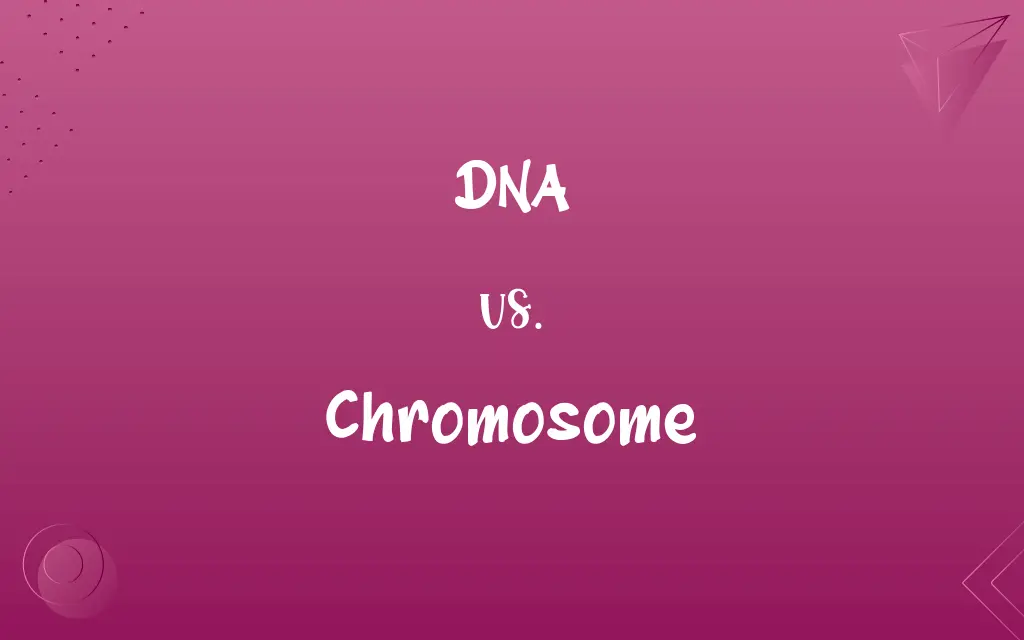DNA vs. Chromosome: Know the Difference

By Shumaila Saeed || Published on January 10, 2024
DNA is the molecular blueprint for life, storing genetic information, while a chromosome is a structure composed of DNA and proteins, organizing and condensing this information for cellular processes.

Key Differences
DNA, or deoxyribonucleic acid, is a molecule that holds the genetic instructions essential for the development and functioning of living organisms. Chromosomes, on the other hand, are thread-like structures located within the nucleus of animal and plant cells, made of protein and a single molecule of DNA.
Shumaila Saeed
Jan 10, 2024
The role of DNA is to carry the genetic information required for the replication of cells and the production of proteins, which are critical for life processes. Chromosomes serve to package this DNA into a more compact, manageable form, helping in its equal distribution during cell division.
Shumaila Saeed
Jan 10, 2024
DNA is composed of two strands forming a double helix, with sequences of nucleotides that encode genetic information. Chromosomes are formed by DNA tightly coiled many times around proteins called histones, which support its structure.
Shumaila Saeed
Jan 10, 2024
The human genome contains approximately 3 billion base pairs of DNA, organized into 23 pairs of chromosomes. Each chromosome contains hundreds to thousands of genes, which are segments of DNA carrying instructions for specific traits or functions.
Shumaila Saeed
Jan 10, 2024
In summary, while DNA is the fundamental substance of genes and genetic information, chromosomes are the larger structures that organize and contain DNA, facilitating its function in the cell.
Shumaila Saeed
Jan 10, 2024
ADVERTISEMENT
Comparison Chart
Structure
Double helix molecular structure
Thread-like structure composed of DNA and proteins
Shumaila Saeed
Jan 10, 2024
Function
Carries genetic information
Organizes and condenses genetic information
Shumaila Saeed
Jan 10, 2024
Composition
Nucleotides (Adenine, Thymine, Cytosine, Guanine)
DNA and histone proteins
Shumaila Saeed
Jan 10, 2024
Role in Cell Division
Replicates to pass genetic information
Ensures accurate distribution of DNA during cell division
Shumaila Saeed
Jan 10, 2024
ADVERTISEMENT
DNA and Chromosome Definitions
DNA
DNA is the molecule carrying genetic instructions for the development of living organisms.
The DNA sequence determines a person's eye color.
Shumaila Saeed
Dec 17, 2023
Chromosome
Chromosomes ensure the accurate transmission of genetic information during cell division.
Chromosomal abnormalities can result in genetic disorders.
Shumaila Saeed
Dec 17, 2023
DNA
DNA, short for deoxyribonucleic acid, is the hereditary material in humans and most other organisms.
Researchers study DNA to understand genetic diseases.
Shumaila Saeed
Dec 17, 2023
Chromosome
Chromosomes are structures within cells that contain DNA and protein.
Humans have 23 pairs of chromosomes in each cell.
Shumaila Saeed
Dec 17, 2023
DNA
DNA is the code that guides the growth, development, functioning, and reproduction of all known living organisms.
DNA mutations can lead to changes in an organism's characteristics.
Shumaila Saeed
Dec 17, 2023
ADVERTISEMENT
Chromosome
Chromosomes carry genes, the basic units of heredity, in a linear sequence.
A chromosome may contain hundreds to thousands of genes.
Shumaila Saeed
Dec 17, 2023
DNA
DNA consists of two long chains of nucleotides twisted into a double helix.
The DNA double helix is an iconic symbol of biology.
Shumaila Saeed
Dec 17, 2023
Chromosome
Chromosomes are made of DNA tightly coiled around proteins called histones.
The structure of chromosomes changes throughout the cell cycle.
Shumaila Saeed
Dec 17, 2023
DNA
DNA contains the instructions needed to build and maintain an organism.
DNA in a seed determines the type of plant it will grow into.
Shumaila Saeed
Dec 17, 2023
Chromosome
Chromosomes are the packaged form of genetic material in the nucleus of eukaryotic cells.
During cell division, chromosomes become visible under a microscope.
Shumaila Saeed
Dec 17, 2023
DNA
A nucleic acid that carries the genetic information in cells and some viruses, consisting of two long chains of nucleotides twisted into a double helix and joined by hydrogen bonds between the complementary bases adenine and thymine or cytosine and guanine. DNA sequences are replicated by the cell prior to cell division and may include genes, intergenic spacers, and regions that bind to regulatory proteins.
Shumaila Saeed
Dec 13, 2023
Chromosome
A linear strand of DNA and associated proteins in the nucleus of eukaryotic cells that carries the genes and functions in the transmission of hereditary information.
Shumaila Saeed
Dec 13, 2023
Chromosome
A circular strand of DNA in bacteria and archaea that contains the hereditary information necessary for cell life.
Shumaila Saeed
Dec 13, 2023
DNA
Abbreviation for deoxyribonucleic acid; - more commonly used than the full name. See also RNA.
Shumaila Saeed
Dec 13, 2023
Chromosome
A linear arrangement of condensed DNA and associated proteins (such as chaperone proteins) which contains the genetic material (genome) of an organism.
Chromosomes store genetic information.
Shumaila Saeed
Dec 13, 2023
DNA
(biochemistry) a long linear polymer found in the nucleus of a cell and formed from nucleotides and shaped like a double helix; associated with the transmission of genetic information;
DNA is the king of molecules
Shumaila Saeed
Dec 13, 2023
Chromosome
One of the minute bodies into which the chromatin of the nucleus is resolved during mitotic cell division; the idant of Weismann.
Shumaila Saeed
Dec 13, 2023
Chromosome
A threadlike body in the cell nucleus that carries the genes in a linear order
Shumaila Saeed
Dec 13, 2023
Repeatedly Asked Queries
What is DNA?
DNA is the molecule that carries the genetic instructions for living organisms.
Shumaila Saeed
Jan 10, 2024
How many chromosomes do humans have?
Humans typically have 23 pairs of chromosomes in each cell.
Shumaila Saeed
Jan 10, 2024
What are chromosomes?
Chromosomes are structures in cells that organize and contain DNA and proteins.
Shumaila Saeed
Jan 10, 2024
What is the function of DNA?
DNA's primary function is to store and transmit genetic information.
Shumaila Saeed
Jan 10, 2024
What is the role of chromosomes in heredity?
Chromosomes carry genes, which are passed from parents to offspring, determining hereditary traits.
Shumaila Saeed
Jan 10, 2024
How are DNA and chromosomes related?
DNA is the substance that makes up chromosomes.
Shumaila Saeed
Jan 10, 2024
What happens to chromosomes during cell division?
During cell division, chromosomes replicate and ensure each new cell receives a complete set of genetic information.
Shumaila Saeed
Jan 10, 2024
Can changes in DNA affect health?
Yes, mutations or changes in DNA can lead to various health issues, including genetic disorders.
Shumaila Saeed
Jan 10, 2024
How are genes related to DNA and chromosomes?
Genes are segments of DNA located on chromosomes, carrying instructions for specific traits or functions.
Shumaila Saeed
Jan 10, 2024
Can DNA be seen under a microscope?
DNA itself is too small to be seen, but when packaged into chromosomes, it can be observed under a microscope.
Shumaila Saeed
Jan 10, 2024
What is chromosomal DNA?
Chromosomal DNA refers to the DNA contained within the chromosomes of a cell.
Shumaila Saeed
Jan 10, 2024
What role do chromosomes play in genetic testing?
Chromosomes are analyzed in genetic testing to detect abnormalities or mutations.
Shumaila Saeed
Jan 10, 2024
How is DNA extracted for testing?
DNA is extracted from cells through a process that involves breaking down the cell membrane and separating DNA from other cell components.
Shumaila Saeed
Jan 10, 2024
How is DNA replicated?
DNA replication involves the unwinding of the double helix and the formation of two new complementary strands.
Shumaila Saeed
Jan 10, 2024
What is a DNA double helix?
The DNA double helix is the twisted ladder-like structure of DNA molecules.
Shumaila Saeed
Jan 10, 2024
Are all chromosomes the same size?
No, chromosomes vary in size and can carry different numbers of genes.
Shumaila Saeed
Jan 10, 2024
How do environmental factors affect DNA?
Environmental factors can cause mutations in DNA, affecting gene expression and potentially leading to diseases.
Shumaila Saeed
Jan 10, 2024
What are histones in chromosomes?
Histones are proteins around which DNA wraps in chromosomes, aiding in packaging.
Shumaila Saeed
Jan 10, 2024
Can DNA be repaired?
Yes, cells have mechanisms to repair damaged DNA, although these processes are not always perfect.
Shumaila Saeed
Jan 10, 2024
What are autosomes and sex chromosomes?
Autosomes are non-sex chromosomes, while sex chromosomes determine an individual's biological sex.
Shumaila Saeed
Jan 10, 2024
Share this page
Link for your blog / website
HTML
Link to share via messenger
About Author
Written by
Shumaila SaeedShumaila Saeed, an expert content creator with 6 years of experience, specializes in distilling complex topics into easily digestible comparisons, shining a light on the nuances that both inform and educate readers with clarity and accuracy.









































































